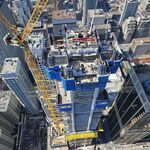Koolgreen
Active Member
I see bulova tower and the flyer...CNE Stadium 1983
View attachment 146189
Not sure if that cylindrical ride is the mouse or wildcat.....
Was this shot from the alpine way gondola?
If so it is pretty high....
I see bulova tower and the flyer...CNE Stadium 1983
View attachment 146189
I see bulova tower and the flyer...
Not sure if that cylindrical ride is the mouse or wildcat.....
Was this shot from the alpine way gondola?
If so it is pretty high....
The cylindrical roller coaster by Lakeshore Blvd is the Jumbo Jet. It had a radical (for the time) 90 degree pitch to the side. How tiny its footprint is next to the Flyer.I see bulova tower and the flyer...
Not sure if that cylindrical ride is the mouse or wildcat.....
Was this shot from the alpine way gondola?
If so it is pretty high....
Down Hill! lol...Today's 'Toronto Scene' for music may be alive, but nowhere near as unique and intense as it was then. Of course, as many of us played in basement bands as didn't. And some of us played so many bars the memory is just a smoke filled haze.Too high to be the gondola.
That shot of the forum at Ontario place brings back some memories of great summer concerts there in the 80s. Doug and the Slugs, David Wilcox, Bruce Cockburn. I'm sure there were many others, but I remember those well. I'm not going to mention that I also went to see Dan Hill there (I fancied a girl who was a big fan).
I'm told by a sometime contributor to this string and other photo ones that Casa Loma was actually structurally concrete. The stone is a veneer. I was initially shocked, but it would make sense considering what I know of structural engineering. It's one thing to relay stone for appearance, another to expect it to retain structural integrity when trying to put compromised pieces back with mortar.Casa Loma construction crew 1912
I'm told by a sometime contributor to this string and other photo ones that Casa Loma was actually structurally concrete. The stone is a veneer. I was initially shocked, but it would make sense considering what I know of structural engineering. It's one thing to relay stone for appearance, another to expect it to retain structural integrity when trying to put compromised pieces back with mortar.
I've dug only superficially to find the story, but did trip across "Roman Stone" being used, at least for restoration, which is formed from concrete. I'll keep digging to find if it is used structurally. For that time period, to not use a steel superstructure would be an oddity, but I'll find out the story.There appears to be little evidence of concrete construction in this amazing photo.
https://www.theglobeandmail.com/news/national/casa-lomas-identity-crisis/article18228672/[...]
But all is not well with Casa Loma, a heritage jewel that many believe is suffering from an identity crisis. For years, its bread-and-butter function has been as a tourist icon and party venue, catering to a steady stream of school trips, American bus tours, film shoots and special events.
Now some say it's time to liberate the castle from its cliché as "Sir Henry's folly" and reposition it both as an authentic homage to Edwardian-era Toronto and as a modern-day asset for the local community.
Ms. Howell, a self-professed romantic, contends that the current tourist focus pays only lip service to her ancestors' accomplishments. "It's an embarrassment," she charges, citing the care-worn interior, a touristy gift shop in the basement and a vacant hunting lodge across the street.
She is not the only one asking questions about the landmark building's public image.
A volunteer advisory committee, appointed by the city, will hold a public meeting next Tuesday at St. Lawrence Hall, as part of an ongoing review of the future of Casa Loma.
"It is one heck of an impressive building that a lot of people have a sentimental attachment to," says lawyer Ron Kanter, the committee chairman. "We want to try and ensure it is managed, operated and promoted in a way that maximizes its draw to both Torontonians and tourism."
Figuring out the best future for the building will take time, money and likely some testy debate. But architect Charles Hazell, a partner in Taylor, Hazell, is among those convinced that Casa Loma can escape from its recent past.
"It is part of a singular collection of buildings that define our culture," says Mr. Hazell, whose firm has been hired by the city to carry out a long-overdue restoration of the exterior. "People are used to characterizing it in a certain way," he notes, either in superficial terms as a tourist site or as a "problem" building in need of costly upkeep.
Instead, he said, the public should see Casa Loma in a different light. "It should be viewed as a place demonstrating great achievement, huge generosity and a welcoming venue," he said, crediting Sir Henry with commissioning a pseudo-medieval mansion that was a marvel of modern construction at the time, complete with electricity, water works and telephones.
He pioneered the use of Roman Stone, a synthetic building material now being replicated in the restoration work being carried out by Mr. Hazell's company.[...]
http://casalomatrust.ca/2005/07/19/jul-9-2005-star-how-a-casa-crumbles/[...]
As Hazell explains, the problems with the exterior go back to the 1980s when, to delay proper maintenance, the city had the outside walls coated and painted over. This had the effect of trapping moisture inside the blocks. It froze, expanded and burst the cast stone to pieces.
"Pellatt's architect, E.J. Lennox, used a product called Roman Stone, a precursor of precast concrete," Hazell says. "It was a type of solidified mortar. It was superb at handling our climate and it can be carved. The problems happened because it was coated with Portland cement and latex paint. You can see in the areas that weren't touched the Roman Stone is doing just fine."
Ever the entrepreneur, Pellatt had seen Roman Stone in the U.S. and hoped to introduce it to Canada as a building material of the future. Whatever other intentions he had for Casa Loma, it was also to be a showcase of this new technology.
"It is a lovely material," Hazell insists. "But we wrecked it."
[...]
http://www3.sympatico.ca/goweezer/canada/casaloma.htm[...] Meanwhile, Edward J. Lennox began designing the castle in 1909. A year later, the foundation was laid. The first Credit Valley stone was set in April of 1911. The towers went up in 1912. By 1913, the final stones were laid and Casa Loma was a reality. In all, more than 300 trades people (all personally selected by Henry) had worked to complete the huge castle in only three years, with Henry over-seeing every aspect of the operation. It is said that he also personally approved every stone that was to become a part of his home. According to legend, the stone wall surrounding Casa Loma was constructed from stones shipped over from Scotland and Scottish stoneworkers were brought over to construct it in authentic Scottish style.
[...]
Reconstituted Stones!Palais Royale at Sunnyside 1946 TPL
http://www.trainweb.org/oldtimetrains/TSR/guelph_radial.htm[...]
The Great War (World War I) had slowed down work, and it did not open for some time as it was further delayed for more than a year by court orders brought about by the City of Toronto over the fear freight cars would be hauled on the street because the TSR sought to standard gauge (4 feet, 8 ½ inches) the existing Lambton (broad gauge 4 foot 10 ¾ inches) route along Dundas Street to allow radial cars to operate as far as the Junction. Eventually, the railway prevailed and the line finally opened to the public on April 14, 1917. The entire TSR system was standard gauged in 1917.
[...]
On November 15, 1923 all TSR lines within the city of Toronto were acquired and turned over to their TTC which had been established September 1, 1921 to operate all public transportation in the city. This saw the radial service on Dundas ended due to the track being re-gauged to the broader TTC gauge of 4 feet 10 and 5/8 inches, just slightly narrower than the TRC and TSR old gauge of 4 feet 10 and 3/4 inches, as far as the city limit at Runnymede Road. Radial cars had to wye at Lambton and back east along the roadside of Dundas to Willard Avenue to connect with the TTC. Why here? Willard is two blocks east of Jane Street but, still four blocks short of Runnymede. It may have been some sort of compromise possibly having to do with the schedule and the additional running time caused by having to wye at Lambton. Rather than build a wye at Runnymede involving two gauges such as existed in the Junction this method was chosen possibly with the knowledge of a new right-of-way to soon be built.
This changed again when on November 25, 1924 the Lambton route of the TSR was acquired by the Township of York and handed over to the TTC to operate. Radial service then ended at Lambton where passengers transferred to old ex-TRC cars used on the Lambton route as far as Runnymede where for some unknown reason (possibly having to do with fares) they were again required to make a transfer to the TTC Dundas car to reach the Junction. Luckily, this didn't last very long as the streetcar line was replaced August 17, 1928 by a bus service which again ran directly from Lambton to the Junction. It was soon extended to Lambton Avenue (Prince Edward Drive), on June 24, 1929 when the new high-level bridge on Dundas Street over the Humber River opened.
[...]




